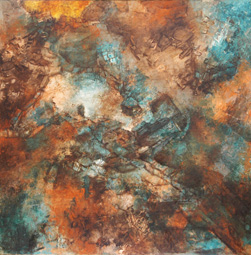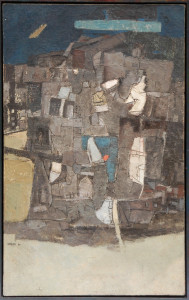Return Table of Contents
Eleonore Chowdhury-Haberl (born in Klagenfurt, Austria) lived in Mumbai, India for 21 years. She was married to Indian industrialist Bilwa Chowdhury who was one of the first serious collectors of modern Indian paintings. Through her husband ́s engagement in art, she became a witness of the early years of the Indian modernist period and actively participated during her 21 years stay in Mumbai in the vibrant art scene of the early sixties late until the early eighties of the last century. She saw the emergence of the group of artists who are now called THE MODERNS, and which formed the core of the Chowdhury collection. The Chowdhury family collection is now to be found in Vienna and in Mumbai.
Editors note: Included with this essay are video “asides”. The videos were made in a Vienna cafe in July 2014. I have included a few stories about some of the artist that Eleonore knew personally. I wish to thank Eleonore for her insights into the “Moderns”.
THE DEVELOPMENT OF INDIAN ART IN THE LAST 60 YEARS
In 1947, the year India achieved independence from British rule, some artists from the Sir J.J. School of Art in Mumbai formed the so-called PROGRESSIVE ARTISTS GROUP, now known as the MODERNS. For the last l5 years or so, the international auction houses have been holding spring and autumn auctions of works by artists from this group. Prices for their works have steadily risen. Buyers are foreign and Indian Museums, as well as private international collectors
When and how did the modern and contemporary Indian art development start?
The Historical background:
Already during British rule, art schools were established in several major cities of India. The most important of these art schools was the Sir J.J. School of Art in Bombay. Sir J.J. stands for Jamshedji Jeejeebhoy, a prominent Bombay citizen and a great philanthropist, who was knighted by the British rulers. It was he who donated most of the funds for the building of the art school which was opened in l888. The first dean of the Bombay art school was Lockhart Kipling, the father of Rudyard Kipling. In fact, Rudyard Kipling was born in the dean´s house, a sprawling colonial manor which still stands today in the large grounds of the Bombay art school.
At the Indian art schools, art instruction was in keeping with the then-prevailing academic, naturalistic Royal Academy of London style- naturalistic and conservative, and with colonial overtones. Although this was India, art instruction did not take the great Indian artistic heritage into consideration – with its grand temple architecture, the fresco – paintings in the Buddhist cave temples, the tradition of miniature paintings (as practiced at the royal courts) nor the Indian tradition of depicting religious or mythological themes on cloth or paper(In India there was never a tradition of painting on canvas.).
Not happy with what was taught at the J.J. School of Art, the young artists looked for a new style, away from the cultural and artistic restrictions which were forced on them at the art school. From the background of Indian miniature painting, folk-art, and Western naturalism as taught at the art school, they were to find their own mode of expression. They were determined to create art which was Indian through and through, but yet modern and of the times. This determination to break with tradition and to follow a new course prompted some artists to form the so-called Progressive Artists´Group – later known as THE MODERNS. This was in the year l947. The painters who originally formed this group were M.F. Husein, F.N. Souza, S.H. Raza, H.A. Gade, A.S. Bakre, K.H. Ara, and a few others. Today, V.S. Gaitonde, Akbar Padamsee, Ram Kumar as well as Tyeb Mehta, Krishen Khanna, and Bal Chhabda are also included in this group.
Although from different religious, caste, and regional backgrounds, they became a closely knit group of friends with a common goal: to find a form of expression which would reflect modern trends as well as their Indianness. The immediate post-independence years were a period of artistic confusion, but also a time of awakening for India after centuries of colonial rule. French post-impressionism and abstract expressionism was still visible in their work, but these styles were desired and sought – influenced by Jawarhalal Nehru´s wish to make India international (Jawarhalal Nehru was the first Prime Minister of independent India).
GERMAN AND AUSTRIAN WAR EMIGRÉS
An interesting facet of that crucial period was that from l935 onwards, several hundred German and Austrian Jews fleeing from persecution in Nazi Germany had found refuge in British India. The presence of some of these Europeans proved to be significant in the early development of Indian modern art during the war years and in the years following independence. And it also proved to be crucial for bringing about an art consciousness among Indians.
One of these Europeans was Walter Langhammer, a painter and art professor from Vienna. He left Austria in l935 with his Jewish wife. Before his departure, he had already made contacts in India. In Bombay, he first became Art Director of the Times of India, the renowned Bombay newspaper, and, as a former art professor, he soon found employment at the J.J. School of Art.
Emmanuel Schlesinger, a Jewish gentleman from Vienna, who after his arrival in India had started a pharmaceutical company in Bombay, soon began taking an interest in Indian art. He became a great supporter and patron of the young Indian painters.
Dr. Rudolf von Leyden left German for political reasons and arrived in India already in l933. He first became Art Director of the Times of India, and later started a commercial arts studio, for which he employed the young artists from the J.J. School of Art. Rudy von Leyden was to play an important role in the nascent Indian art scene.
These three highly cultured European art lovers took the talented young artists from the J.J. School of Art under their wings, invited them to their homes, discussed with them the latest trends in the West by showing them art books, and encouraged them to follow a new path. They recognized the enormous talent of these young artists, and most importantly, bought their works so that the young artists could live and survive. They organized exhibitions for them and showed the young artists the way to apply for scholarships abroad at the foreign consulates and cultural institutes which had been opened in Bombay after India´s independence.
SCHOLARSHIPS ABROAD
Most of the now famous painters from the MODERNS group obtained scholarships and went to the USA, England, or France. There, they were exposed to new art trends prevailing abroad, which naturally had a great influence on their artistic development. Some of them, like Francis Newton Souza lived in England and in the US for many years and only came back to India during the winter months in order to exhibit his work. He had already achieved a measure of success abroad, and success abroad meant success at home. Soon invitations to the important Biennales followed.
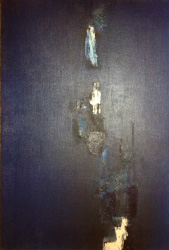
V.S.GAITONDE, blue abstract, 1962. copyright: private collection Mumbai/Vienna. Photo by the author.
Gaitonde, Raza, Husein, Souza, Akbar Padamsee, they were all present at the Biennales in Tokyo, Sao Paolo, at the Documenta, etc. But the real breakthrough in the West was still going to take many years. Only at the beginning of this millennium, with the rise of India as an economic power, prices for paintings by Indian artists from the first generation ( i. e. the MODERNS) began to rise. The newly wealthy Indian middle class wanted to possess paintings by these masters too and they could now afford to buy art.
THE ART SCENE IN THE SIXTIES AND SEVENTIES
Artists had very few opportunities to sell their works. There were very few commercial art galleries. It was only at the annual shows of the Bombay Art Society (established in the late 19th century) where artists could have free exhibition space to show their works.
What was the attitude towards art in general? The upper middle class Indians used to buy traditional art (paintings mostly on cloth or paper depicting scenes from Indian mythology, bronzes or stone sculptures of Hindu gods and goddesses, or miniature paintings). Art patronage was very limited. Artists could not expect to make a living out of their art, but had to rely on commissions or an occasional sale of their work.
THE MODERNS :
Maqbul Fida HUSEIN ( 1915-2011) is no doubt the most famous of the MODERNS. He is one of the painters from the postcolonial era who never went abstract, but continued portraying the pulsating life of India and its fascinating people in his dynamic paintings. He refused to be influenced by the abstract wave which dominated the Indian art scene in the 60s and 70s but remained true to his expressionistic style. His works can be found in many international museums.
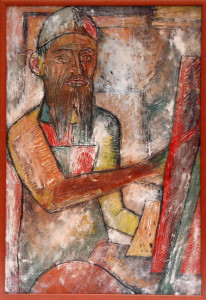
F.N. SOUZA; portrait of M.F.Husain, 1949, copyright: private collection Mumbai/Vienna. Photo by the author.
Francis Newton SOUZA (1924-2002). Influenced by his strict catholic upbringing in Goa, which was until l961 a Portuguese colony, his oeuvre deals critically with the power structures of the Catholic church, Catholic iconography, and the rites of the Catholic church. But Souza also shocked with daring, sensuous portraits of women, and he painted landscapes, mainly cityscapes. After studying at the J. J. School of Art, he went to London to continue his studies. He stayed in England and the USA for many years, only returning to India during the winter months to exhibit his work. He participated in all the important Biennales, and his work is represented in the Tate, London, and in many other museums worldwide.
Akbar PADAMSEE (1928 – ) who lived in France for many years, is another famous member of the MODERNS. He is known for his expressionistic metascape paintings and for his sensitive portraits.
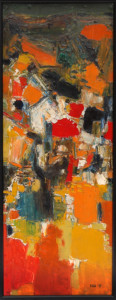
Sayed Hayder RAZA, Village in the Provence, 1959. copyright: private collection Mumbai/Vienna. Photo by the author
Sayed Haider RAZA (1922-) studied at the École des Beaux Arts in Paris. He took part in various Biennales and had several one-man shows in Bombay. He lived in France for many years. First heavily influenced by French expressionism, he turned in his later years, when he stayed in India for longer periods, to severe geometric forms, which contain the mystical aspect of Hindu Philosophy (Raza is now 91 years old and lives in Paris, the Provence and in Bombay.).
Vasudev GAITONDE (1924-2001) is one of India´s leading non-objective painters. In l964 he went to the USA on a Rockefeller scholarship and he later won many international awards. He had a very individualistic style – monochrome, luminous canvasses that are meditative and contemplative. Gaitonde has emerged in the last few years as the most sought-after Indian painter. Recently one of his works was sold in New York for 2.5 million dollars. The Solomon Guggenheim Museum is honouring V.S. Gaitonde in October 2014 with a retrospective of his life work.
Tyeb MEHTA (1925-2009) expresses in his figurative paintings the inner strife of human existence, the suffering, but also hope and joy. He is often called the Francis Bacon of India.
RAM KUMAR (1924-) hails from North India. From l942 to 1959 he lived in Paris and studied under André Lhote and Fernand Léger. After his return to India, he went through a figurative phase in which he expressed the grim reality of human existence in urban India with dark, depressing colours and sad-looking individuals. Later, his work became abstract. He is now considered as one of the most important Indian abstract painters.
KRISHEN KHANNA and MOHAN SAMANT joined the MODERN PROGRESSIVES much later, but should be mentioned here, as well as JEHANGIR SABAVALA (1922-2012) who went a completely different way. After studying with André Lhote in Paris, he returned to Bombay. In his early years, his work shows influences of French and German cubism. He later became known for his aesthetic, poetic landscapes.
Also the Indian sculptors turned away from the naturalism of colonial art and began to experiment with different materials.
THE DEVELOPMENT IN THE LATE 20TH CENTURY
In the following decades- from the middle 60s onwards, artists began experimenting with Pop-art and Neo-Dada and deepened the discourse of Indian art with modern trends. In South India,a group of artists came together who were vehemently opposed to a hybrid culture-and art import from the West. They reverted to traditional techniques.
The seventies were a time of social and political turmoil in India – the war with Pakistan in 1971, the famine, and the Naxalite movement (a Maoist military movement), as well as the introduction of emergency rule in India by the then Prime Minister Indira Gandhi.
The painters expressed these times with a new figurative phase in their work. They considered it as their responsibility as artists to refer to the actual world around them and to show the distress of the people and the national situation in realistic pictures.
CONTEMPORARY INDIAN ART
With disappearing frontiers and India´s increasing globalisation, postmodernism became the preferred mode of expression in Indian art. Photo- and hyperrealism, installation art, New Media, and digital art found their way into the perception of artists and the public. Hybrid ways of expression are now normal and have become familiar.
For the new generation of Indian artists, the international world with all its influences has opened up, and this is also reflected in their work.
These new experiences become visible in the metaphoric montages of Atul Dodya, and the installations of Subodh Gupta, in which he tries to project the daily experiences of the rural people of the Indian middle class. Also the borders between the traditional disciplines, i. e. painting and sculpture, have disappeared with artists like Sudarshan Shetty, Anandajit Ray, and G.R. Iranna.
Simultaneously, with this development of contemporary Indian art, the Indian art market has reacted. A number of galleries and private Museums have opened in India and abroad, catering only to Indian art. Indian art directs itself now to a global audience. One can say that Indian art has gone through a dynamic creative process in the last century. This many-layered pluralistic art will continue to fascinate.
Note: In 1996, the name Bombay was officially changed to MUMBAI, but the old name for the city is still used often. In this essay I mostly refer to “Bombay.”

